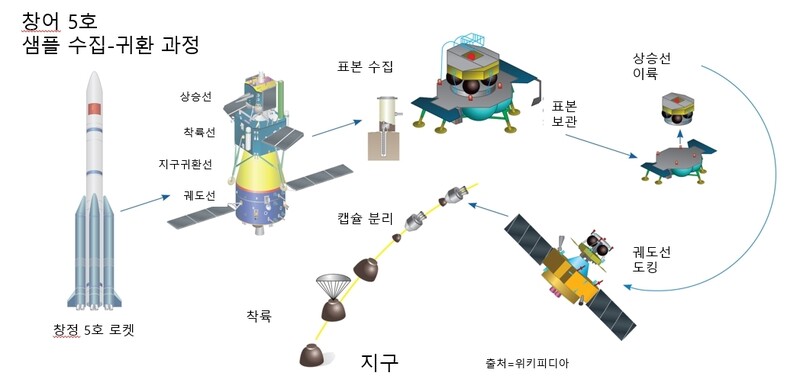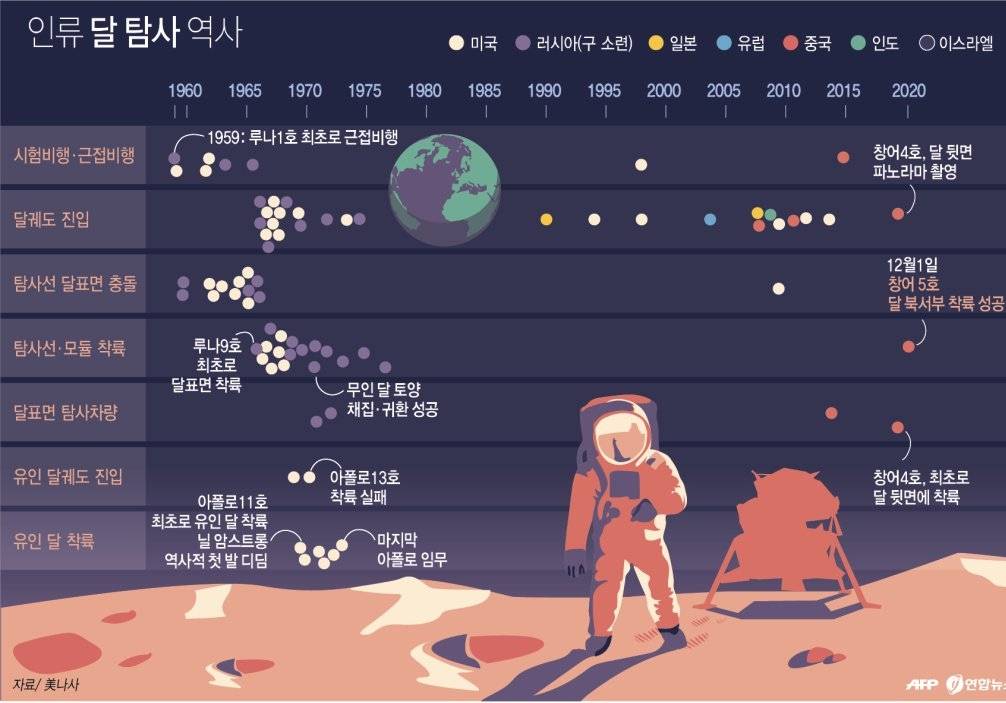Chang’e 5 Returns to Earth
창어 5호(2020년 11월 23일 – 12월 16일)는 중국 달 탐사 계획의 5번째 달 탐사 임무이자 중국 최초의 달 표본 채취 임무이다. 창어 5호는 23일 간의 우주 임무를 마치고 2020년 12월 16일 1,731g의 달 표본을 싣고 지구에 귀환했다. 이는 1976년 소련의 루나 24호 이후 첫 달 표본 채취 임무였다. 이 임무로 중국은 미국과 소련에 이어서 달 표본 채취 성공한 세 번째 나라가 됐다. (음… 나 요즘 달에 꽂혔나봐.😅😅😅)
Transcript
Now you might remember the images last month of a Chinese spacecraft blasting off for the Moon.
지난달에 중국 우주선이 달을 향해 발사된 장면을 아직 기억하고 계시죠?
Well, it’s due to return to Earth in the coming hours, carrying fresh samples of moon rocks and debris.
그 우주선이 몇 시간 후에 달에서 수집한 암석과 파편 등의 표본을 싣고 지구로 돌아올 예정입니다.
Chang’e 5 was one of the most complicated and challenging missions in China’s aerospace history.
창어 5호는 중국 우주 항공 역사상 가장 복잡하고 도전적인 임무 중 하나였습니다.
When the rocket was launched on November 23rd, it was a source of national pride.
11월 23일 발사된 로켓은 중국 자부심의 상징이었습니다.
The probe was made up of 4 modules, one was the lander which is dug for rocks and soil.
탐사선은 4개의 모듈로 구성되었으며, 하나는 암석과 토양을 파내는 착륙선이었습니다.
The materials were then transferred into a return capsule for the journey back to earth.
채취된 표본들은 지구로 돌아가는 귀환선으로 옮겨졌습니다.
And joining us now from the Netherlands is Marc Moccouchran, he’s senior advisor for science and exploration at the European Space Agency.
오늘은 유럽 우주국의 과학 및 탐사고문인 Marc Moccouchran가 네덜란드에서 함께 하시겠습니다.
Mark, Thanks for joining us.
마크, 시간을 내주셔서 감사합니다.
This is a complex mission, it could still end in failure if the spaceship crashes upon landing.
이번 미션은 어려운 미션인데요, 만약에 우주선이 착륙할 때 충돌하면 여전히 실패로 끝날 수 있습니다.
How challenging is the technical side of this mission?
이 임무는 기술적으로 얼마나 어렵습니까?
I think it’s important to realize China could have done this in a simpler way.
사실 중국이 더 간단한 방법으로 할 수 있었다는 것을 알야아 합니다.
It could have had a direct return of lunar samples from the surface, for example, but it’s chosen to do it in a way, which is complicated because it leads to the next step.
예를 들면 달 표면에서 샘플을 직접 반환할 수 있었지만 더 복잡한 방식을 선택했습니다.
It leads to the ability to send humans to the Moon.
이것은 우주인을 달에 보낼 수 있는 능력을 키우기 위해서입니다.
So for example, landing on the surface with an orbiter going around the Moon, and then rendezvousing with that orbiter, reconnecting with it, getting rid of one piece of the spacecraft flying back with another.
예를 들면 착륙선이 표면에 착륙하기 전에 달 주위를 도는 궤도선과 분리된 후, 이후 다시 랑데부하여 재연결됩니다. 그리고 돌아오는 도중에 궤도선을 버리고 귀환선만 다시 돌아옵니다.
These are all the things that the Apollo mission did in the 1960s and 70s.
이것은 1960년대와 70년대에 아폴로 미션이 수행했던 방식과 똑같습니다.
So I think it is more challenging than it needs to be for what it’s doing today, but for a very very specific purpose.
따라서 일반적인 방식이 아니라 특정한 목표를 달성하기 위해 훨씬 더 어려운 방식으로 진행하고 있습니다.
Is that the main purpose then to put humans on the Moon?
주요 목적은 나중에 유인 우주선 달 착륙을 위해 준비하는 거죠?
Well, in this case, of course they’re bringing samples back from an interesting location, a place called Mons Rümker in the Oceanus Procellarum, which is the ocean of storms on the Moon.
맞습니다. 그리고 이번에 달 북서쪽 “폭풍의 대양”의 “륌케르 산”라고 하는 지역에 착륙했습니다.
And in fact it’s a place no other mission has been to before whether Soviet or American.
사실 이 지역은 이전에 소련이나 미국이 탐사한 적이 없는 지역입니다.
The samples there, the minerals on the Moon are much younger than in other locations, so that’s actually important for trying to understand the evolution of the Moon, what happened there billions of years ago.
그 지역에 있는 표본은 다른 지역에 비해 훨씬 어리기 때문에 수십 억년 전에 발생했던 달의 진화 과정을 이해하는데 많은 도움이 될 것입니다.
But China has been putting so much efforts in space exploration in recent years, are we heading into a future where China leads the race, and the U.S. and Europe will be struggling to keep up?
중국은 최근 몇 년 동안 우주 탐사에 많은 노력을 기울이고 있는데, 중국이 우주 경쟁을 주도하고 미국과 유럽이 뒤쫓는 상황이 될까요?
Yeah, well, this narrative about the new space race is constant, but I actually don’t think it like that at all.
글쎄요, 새로운 우주 경쟁 이야기는 계속 이어지고 있지만 저는 사실 그렇게 생각하지 않습니다.
We’re collaborating very actively with China on scientific missions, we’ve also sent some our astronauts to train with China.
우리는 우주 과학 연구 영역에서 중국과 매우 적극적으로 협력하고 있으며 우주인도 함께 훈련하도록 보냈습니다.
So there’s possibility in the future we might actually fly on the Chinese space station, for example.
그래서 미래에 우리가 실제로 중국 우주정거장에서 같이 일할 가능성이 있습니다.
So I think, yes, China is doing very impressive work at the moment.
네, 저는 중국이 현재 아주 잘하고 있다고 생각합니다.
We shouldn’t deny that for a moment.
현 단계에는 이것을 부인하면 안됩니다.
But it’s something which we’re all doing together, I think it’s a very exciting time for a space exploration in the next decade.
하지만 우리 모두가 함께 하고 있는 일이고 앞으로 10년간은 우주 탐사에 있어 아주 흥미로운 시기가 될 것이라고 생각합니다.
Indeed, Marc Moccouchran from European Space Agency, thank you very much.
맞습니다. 유럽 우주국의 Marc Moccouchran씨에게 다시 한 번 감사드립니다.
My pleasure.
감사합니다.
The lunar probe is composed of 4 parts: an ascender, a lander, an orbiter and a returner.
달 탐사선인 창어 5호는 상승선, 착륙선, 궤도선, 귀환선의 4가지 모듈로 구성되어 있다.

